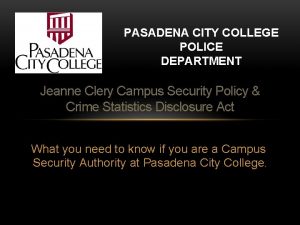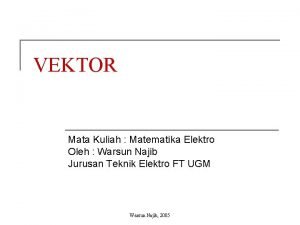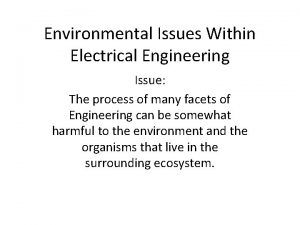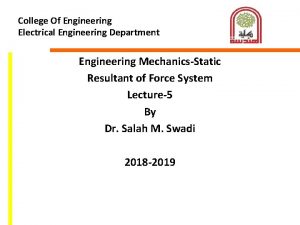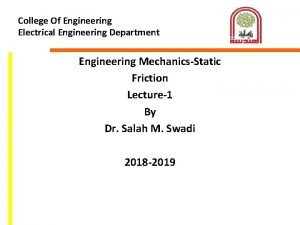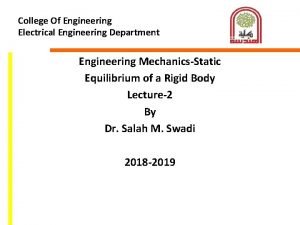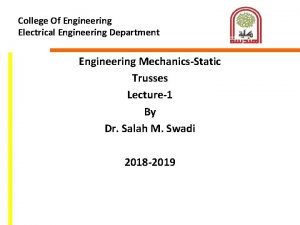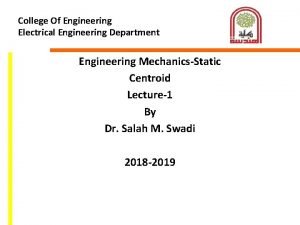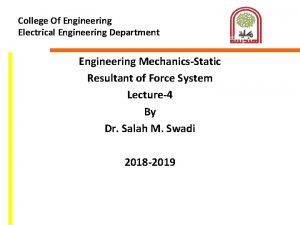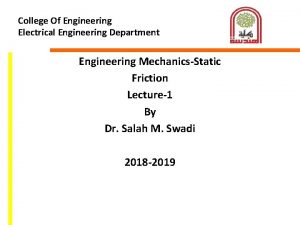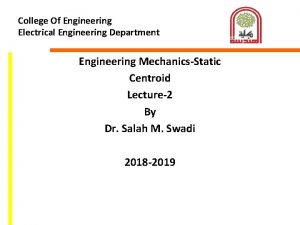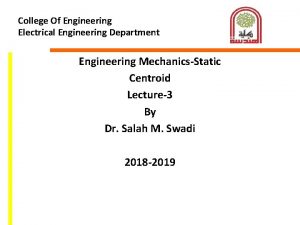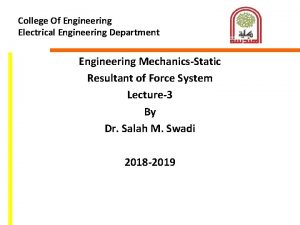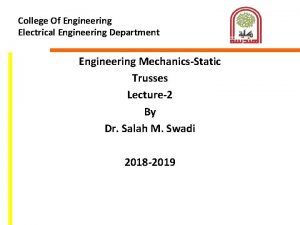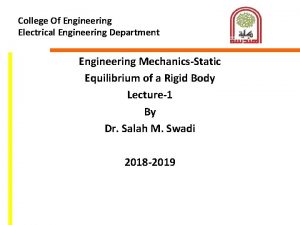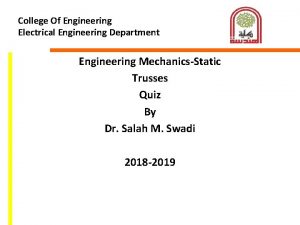College Of Engineering Electrical Engineering Department Engineering MechanicsStatic














- Slides: 14

College Of Engineering Electrical Engineering Department Engineering Mechanics-Static Friction Lecture-2 By Dr. Salah M. Swadi 2018 -2019

8. 2 Problems Involving Dry Friction Types of Friction Problems • In all cases, geometry and dimensions are assumed to be known • 3 types of mechanics problem involving dry friction - Equilibrium - Impending motion at all points - Impending motion at some points

8. 2 Problems Involving Dry Friction Types of Friction Problems Equilibrium • Total number of unknowns = Total number of available equilibrium equations • Frictional forces must satisfy F ≤ μs. N; otherwise, slipping will occur and the body will not remain in equilibrium • We must determine the frictional forces at A and C to check for equilibrium

8. 2 Problems Involving Dry Friction Equilibrium Versus Frictional Equations • Frictional force always acts so as to oppose the relative motion or impede the motion of the body over its contacting surface • Assume the sense of the frictional force that require F to be an “equilibrium” force • Correct sense is made after solving the equilibrium equations • If F is a negative scalar, the sense of F is the reverse of that assumed

Example 8. 1 The uniform crate has a mass of 20 kg. If a force P = 80 N is applied on to the crate, determine if it remains in equilibrium. The coefficient of static friction is μ = 0. 3.

Solution Resultant normal force NC act a distance x from the crate’s center line in order to counteract the tipping effect caused by P. 3 unknowns to be determined by 3 equations of equilibrium.

Solution Solving

Solution Since x is negative, the resultant force acts (slightly) to the left of the crate’s center line. No tipping will occur since x ≤ 0. 4 m Max frictional force which can be developed at the surface of contact Fmax = μs. NC = 0. 3(236 N) = 70. 8 N Since F = 69. 3 N < 70. 8 N, the crate will not slip thou it is close to doing so.

8. 3 Wedges • • • A simple machine used to transform an applied force into much larger forces, directed at approximately right angles to the applied force Used to give small displacements or adjustments to heavy load Consider the wedge used to lift a block of weight W by applying a force P to the wedge

8. 3 Wedges • FBD of the block and the wedge • Exclude the weight of the wedge since it is small compared to weight of the block

Example 8. 6 The uniform stone has a mass of 500 kg and is held in place in the horizontal position using a wedge at B. if the coefficient of static friction μs = 0. 3, at the surfaces of contact, determine the minimum force P needed to remove the wedge. Is the wedge self-locking? Assume that the stone does not slip at A.

Solution Minimum force P requires F = μs NA at the surfaces of contact with the wedge. FBD of the stone and the wedge as below. On the wedge, friction force opposes the motion and on the stone at A, FA ≤ μs. NA, slipping does not occur.

Solution 5 unknowns, 3 equilibrium equations for the stone and 2 for the wedge.

Solution Since P is positive, the wedge must be pulled out. If P is zero, the wedge would remain in place (selflocking) and the frictional forces developed at B and C would satisfy FB < μs. NB FC < μs. NC
 Electrical engineering department
Electrical engineering department Tum department of electrical and computer engineering
Tum department of electrical and computer engineering Ucla ee department
Ucla ee department Pasadena city college police department
Pasadena city college police department Pengurangan vektor
Pengurangan vektor George washington university electrical engineering
George washington university electrical engineering Tel aviv university electrical engineering
Tel aviv university electrical engineering Northwestern computer science department
Northwestern computer science department Klipsch school of electrical and computer engineering
Klipsch school of electrical and computer engineering Umd ee
Umd ee Electrical estimating and costing
Electrical estimating and costing Electrical engineering environmental issues
Electrical engineering environmental issues Wpi bme tracking sheet
Wpi bme tracking sheet Electrical engineering presentation
Electrical engineering presentation Electrical engineering kfupm
Electrical engineering kfupm



